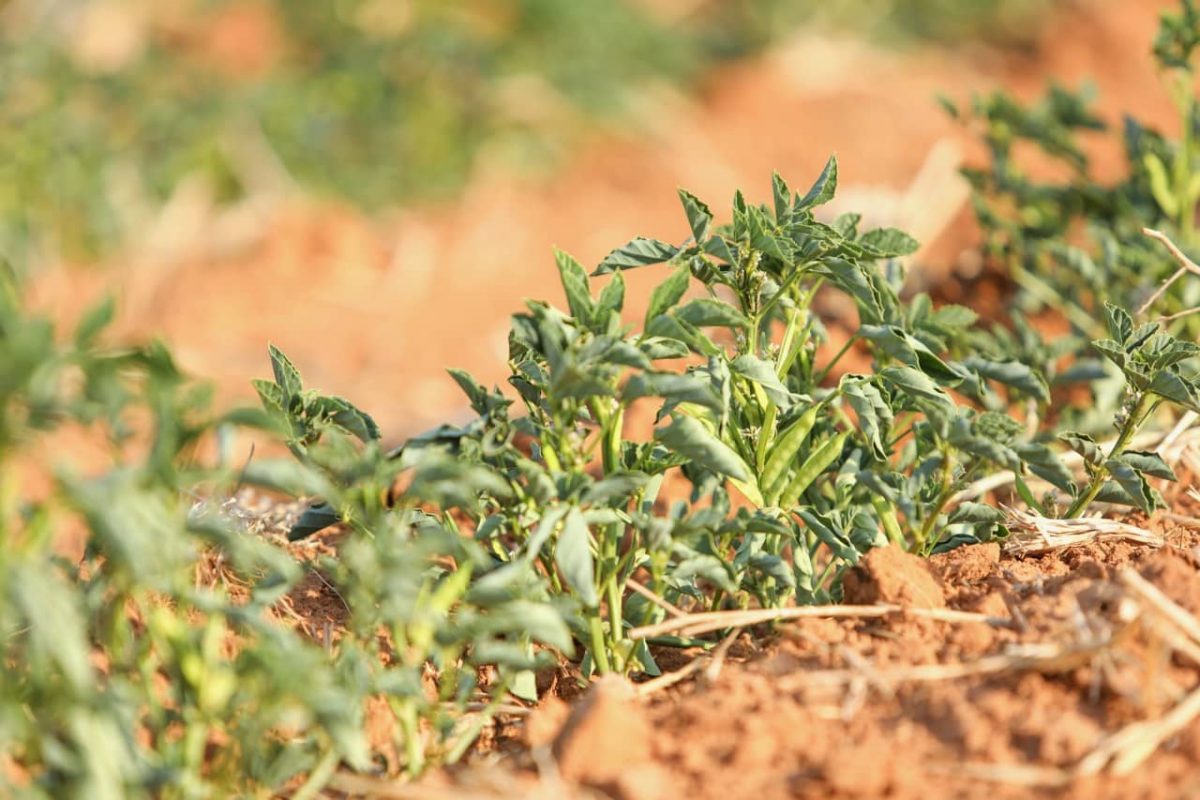
Though some may argue that all gum powders are alike, like most things in life, no two entities, not even identical twins, are exactly the same down to each cell and molecule.
In the case of guar gum and xanthan gum powders, both are common ingredients in foods and gluten-free recipes and serve equally well as general thickeners and emulsifiers. Their differences, however, are as varied, if not more so, than their similarities, and these differences are why more and more consumers and manufactures are increasingly choosing Guar over Xanthan.

Guar gum, aka guaran, hails from India, which is currently the largest global provider of guar gum powder and is responsible for some 80% of the world’s total output. The powder derives from the seeds of a bean-like plant (legume) sometimes known as The Indian Tree.
More recently, larger amounts of guar are being planted in other countries as well, such as China, Africa, Australia and within the United States, where we (Guar Resources) are the leading producer and purveyor and have been producing millions of pounds of USDA certified guar gum powder annually since 2014.

Before investing in gum powder, the consumer should always do some research to ensure the purchase of a worthwhile product that he or she will be inclined to buy again, which often leads to the age old question of which gum powder is better for baking and cooking, specifically gluten-free baking.
The choice is subjective, and for many cooks is both a conflict dependent on preference, and also the reason why both gums are sometimes used together, each rendering its specific advantages to a recipe.
Here are 6 reasons guar powder should be a staple of every kitchen cabinet!

Similarities Between Guar Gum and Xanthan Gum
These two little white powdery substances may look and feel the same, but they aren’t.
Both gums can sustain the stability of both dough and batter almost equally. Xanthan gum and guar gum are used in gluten-free baking to help mimic the protein structure that is naturally provided by the gluten found in wheat, rye, barley or triticale flour, (which is both low in gluten and very heavy). When used in breads, it is usually mixed with rye or wheat flours).
Both gum powders stabilize mixtures, prevent oil droplets from sticking together and separating and solid particles from settling to the bottom.
In some recipes, the two gums can be used interchangeably, and in others, best results occur when the two are used in tandem. When both gums are called for in a specific recipe, they tend to work best when, with the aid of a blender or food processor, they are added to the designated oil component and thoroughly mixed before the other liquid ingredients are added to the recipe.
While both gums are thickening agents that maintain viscosity, their similarities stop there.
Differences Between Guar Gum and Xanthan Gum
The choice of one gum over the other will most likely affect the end result of the baked product. Generally speaking, it can be said that guar gum is best for cold foods, such as ice cream or pastry fillings, while xanthan gum, some say, is better for baked goods.

That said, there are an array of reasons consumers and manufacturers opt to use Guar over Xanthan — they are as follows.
How Xanthan And Guar Are Sourced Differs Greatly
Xanthan gum is primarily made from fermented corn. Its moniker derives from the name of the bacteria from which it grows (Xanthonomas campestris).
It transforms into a gel that subsequently dries into a powder, which is ultimately known to the gluten-conscious world as xanthan gum. The fermenting process can be problematic for many consumers because corn is one of the most genetically modified foods on the modern market place, and as such, is not likely to contain natural or organic components.
Contrarily, the guar gum powder we produce and provide is made from guar beans grown in the United States using sustainable farming practices and is USDA certified organic. The majority of guar is grown for its endosperm, and it is approximately 50% protein, with the endosperm being 28%, and 22% hull. This endosperm is utilized as a stabilizer, emulsifier and thickener in many food products.
Guar gum is commercially extracted from the seeds of the plant via a 4-step process that includes: roasting, de-husking, grinding and sieving. The remaining purified, powdery substance is an off-white, flour-like powder with an earthy odor.
Guar Gum Powder Is More Versatile
The versatility, popularity and chemical properties of guar gum sets it apart from its competitors. In fact, guar extracts are utilized in a myriad of industries besides food, which include: the animal feed; farming; horticulture; cosmetic; pharmaceutical; petrochemical, textile; paper production, mining and construction industries.
Guar Is The Most Cost-Effective Thickening Agent
Xanthan gum is generally a little more expensive than guar gum, with prices running about $5 more than guar for an 8-ounce package. Due to the increasing demand for guar as an application in oil drilling applications particularly, there have been some price fluctuations over the last few years. That said, Guar still remains the most efficient and cost-effective thickening agent on the market today.
The Taste Of Guar Is More Natural
Taste is an important difference between the two gums and is often the deciding factor on which one will be purchased. Due to the fact that xantham gum is man-made, its taste is controlled, and the chemicals that are used in production can render an unpleasant aftertaste.
This is never the case with guar gum powder, which at most may retain a beanie/earthy taste.
And with consumers’ interest increasingly shifting towards products they perceive as “natural” or “less processed,” guar is becoming a preference as an emulsifier and stabilizer in foods over Xanthan or other artificial ingredients.
Guar Has A Much Longer Shelf Life
In its dry form and when properly warehoused, xanthan gum can last indefinitely. However, its shelf life is limited, and it is not recommended for use after the expiration date because it doesn’t work as well.
On the other hand, guar gum powder can retain its properties for as long as 12 to 18 months, and this time can even be extended with the addition of certain preservatives.
Guar is A Much More Effective Thickening Agent
It is estimated that guar gum has almost 8 times the thickening power of cornstarch, which has twice the thickening strength of flour. In terms of recipe applications, for every 2 tablespoons of flour per cup of liquid, about 3/8 teaspoon of guar gum would be required.
The Leading Supplier of USDA-Certified Organic Guar
Guar Resources is the only USA-based manufacturer and supplier of guar gum powder that’s made from USA-grown guar beans.

We provide texture, thickening, emulsifying and stabilizing solutions to a vast array of global industries, and while the majority of the world’s guar is currently produced outside of the United States, more and more companies are turning to our Guar product for the absolute transparency, quality and fully-traceable dependability we provide over other guar suppliers.

Located deep in the heart of America’s southern plains in Brownfield, Texas, our guar processing facility and its environs provide the perfect climate for growing drought-resistant guar gum, offering just the right amount of rain at the correct time.
Focused solely on bean splitting and powder production 24/7, we are the only producer of guar that is USDA certified and approved.
In conclusion
The popularity of guar continues to grow in many diverse applications and industries including: manufacturing, food production and cooking and pharmaceuticals, just to name a few.
For those who are in the gluten-free know, guar gum powder is fast becoming as common a staple in kitchen cabinets as salt and pepper. Guar gum reigns supreme in its capabilities for cold applications such as: ice-cream, shakes and smoothies, and far exceeds the capacity of other gums used in gluten-free cooking.
Try some guar gum powder today. The truth will set you and your recipes free!
Discover how guar rebuilds texture in sugar beverages..

Four Tried And True Guar Gum Recipes
The following recipes come from a variety of sources, including: Guar Resources, Tops Market, Gluten Free and More and Meatloaf and Melodrama.
Gluten Free Chocolate Chip Cookies
Ingredients:
1 1/4 cups rice flour
1 1/4 cups sorghum flour
1/2 teaspoon baking powder
2 1/2 teaspoons salt
1 teaspoon guar gum
1 1/2 cups packed light brown sugar
1/4 cup plus 1 Tablespoon sugar
1/2 cup (1 stick) unsalted butter, room temperature
3 eggs
4 teaspoons vanilla extract
2 cups semi-sweet chocolate chips
Directions:
1. Combine the two flours, baking powder, salt, guar gum and both sugars in a mixer using a paddle attachment and beat until well blended.
2. Add the softened butter and beat until combined; then add eggs and vanilla and mix well. Beat for an extra minute and then add chocolate chips.
3. Cover and refrigerate for at least 2 hours and up to 2 days.
4. Preheat oven to 325 degrees.
5. Form the dough into balls onto either parchment paper or a silicone mat.
6. Flatten each ball slightly, as the dough does not spread much while baking.
7. Bake for 13 minutes if doughy and soft cookies are preferred, and up to 17 minutes if crunchier is desired.
Lay’s Chocolate and Potato Chip Cookies
Ingredients:
2 cups all purpose gluten free baking flour (or favored type)
1/2 teaspoon guar gum
1/4 teaspoon sea salt
2 teaspoons baking powder
1/2 teaspoon baking soda
1 1/2 cups light brown sugar
1/2 cup butter (for crispy) or canola oil (for chewy cookies)
1 egg
2 Tablespoons agave nectar
1 1/2 Tablespoons vanilla extract
1/2 cup brewed coffee
2 Tablespoons unsweetened coconut
1/2 cup mini-chocolate chips
4 cups (5 ounces) potato chips (about 75 chips), processed until finely minced.
Directions:
Preheat oven to 350 degrees F.
2. Process 4 cups (about half the bag) of potato chips and weigh to measure 5 ounces.
3. In a large bowl, whisk together flour, guar gum, salt, baking powder and baking soda.
4. Stir in the brown sugar, combine and mix well.
5. In a separate bowl, whisk together the butter (or oil), egg, agave nectar, vanilla extract, and 5 tablespoons brewed coffee.
6. Combine wet and dry ingredients, mix well and stir until smooth. If the dough is too stiff, add more coffee to soften. The finished dough should be thick.
7. Stir in coconut, chocolate chips and potato chips.
8. Roll dough into balls about one and one half inch around and place 2 inches apart onto a sheet pan lined with parchment. Bake on the bottom rack for 15-17 minutes.
9. Remove from oven, let sit for 5 minutes and then transfer cookies to a cooling rack.
10. Repeat until all dough is used.
Gluten Free Banana Ginger Muffins
Ingredients:
2 cups chopped banana
1/3 cup coconut oil melted
1/2 cup honey or agave nectar
2 eggs
1/2 teaspoon vanilla or almond extract
2 cups gluten-free all purpose flour
2 teaspoons baking powder
1 1/8 teaspoons baking soda
1 teaspoon guar gum
1 teaspoon ground ginger
1/4 teaspoon salt
Directions:
1. Preheat oven to 325°F. Grease 10 cups of a muffin tin.
2. Mash down bananas with fork or potato masher, leaving it slightly clumpy. Mix with coconut oil, honey, eggs and vanilla.
3. In a large bowl, combine remaining ingredients. Stir banana mixture into the dry ingredients and gently mix until combined.
4. Divide batter among 10 greased muffin cups. Place in pre-heated oven and bake for 28 minutes or until toothpick comes out clean.
Bit Of Banana Applesauce Muffins
Ingredients:
1 egg, chicken or duck, or egg replacer
1 Tablespoon coconut oil melted (other oil will work as well)
1 3/4 cups applesauce, unsweetened
1/2 banana mashed
1 cup brown rice flour
3/4 cup garbanzo bean flour or other gluten-free flour such as oat
3/4 teaspoon baking soda
2 tsp baking powder
3/4 teaspoon guar gum
1/4 teaspoon salt
1/2 cup raisins, optional
Directions:
1. Preheat oven to 375 degrees. Prepare a muffin tin with a non-stick spray or liners.
2. In a medium-size bowl, add the egg or egg replacer, melted coconut oil, applesauce, and banana.
3. Mix well using a wire whisk.
4. In a small bowl, add flours, baking soda, baking powder, and guar gum.
5. Add dry mixture to applesauce mixture, mix well with a large spoon and stir in raisins.
6. Fill muffin tins 3/4 full. Bake for 20-25 minutes. Check after 20 minutes.
7. Let sit a couple of minutes before removing muffins from pan. Cool on a wire rack.
8. Store in the refrigerator for several days or freeze for longer storage.
Photo Credits: Pixabay





